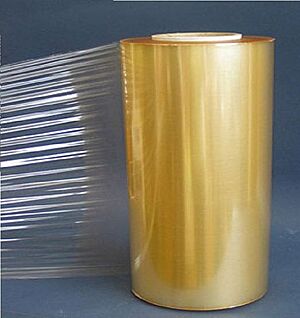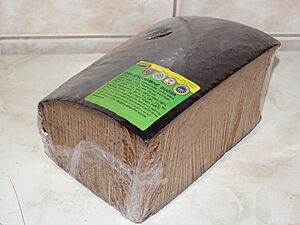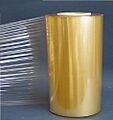Plastic wrap facts for kids
Plastic wrap, also known as cling film or food wrap, is a very thin sheet of plastic. People use it to cover food items in containers. This helps keep the food fresh for a longer time. Plastic wrap usually comes on rolls in a box with a cutting edge. It sticks to many smooth surfaces, so it can stay tight over a container's opening without needing glue. Most plastic wrap for homes is about 8 to 10 micrometers thick, which is super thin!
Contents
What is Plastic Wrap Made Of?
Plastic wrap was first made from a material called polyvinyl chloride (PVC). PVC is still the most common material used around the world. It's good because it doesn't let much water vapor or oxygen through, which helps keep food fresh. However, some people worry that tiny amounts of chemicals called plasticizers from PVC might move into the food.
Another common and cheaper material is low-density polyethylene (LDPE). It doesn't stick as well as PVC, but adding linear low-density polyethylene (LLDPE) can make it stick better and also make the film stronger.
In some places like the US and Japan, plastic wrap is sometimes made using polyvinylidene chloride (PVdC). But some brands, like Saran wrap, have changed to different materials because of environmental concerns.
How We Use Plastic Wrap for Food
Why We Use It
The main reason we use plastic wrap for food packaging is to protect and preserve food. It helps stop food from going bad, makes it last longer, and keeps it tasting good. Plastic wrap protects food in a few ways:
- It stops gases, moisture, and light from getting in.
- It keeps out tiny living things like germs, insects, and animals.
- It protects food from physical damage.
Besides protecting food, plastic wrap can also help reduce food waste. It can be used to label food information, make it easier to move food around, and even make products look better. Some types are also safe for use in the microwave.
Is Plastic Wrap Safe for Food?
Plastic materials are very popular in the food industry because they are cheap and handy. However, some people have worried about chemicals possibly moving from the plastic into food. Plastic packages are made from different materials, and they often have extra ingredients like lubricants, plasticizers, and colorants to make them better.
The FDA in the US checks these materials carefully. They make sure that any tiny amounts of substances that might move into food are at safe levels. For example, there were concerns about a plasticizer called diethylhexyl adipate (DEHA). The FDA found that even if some DEHA moves into food, the amount is much lower than what would cause harm in animal studies.
There were also false rumors that plastics contain dioxins, which are harmful chemicals. The FDA has stated that there is no proof that plastic containers or films contain dioxins. So, when used correctly, plastic wrap is generally considered safe for human health.
Environmental Concerns About Plastic Wrap
The growing amount of plastic waste on Earth is a big problem for both wildlife and our planet. Plastic pieces can choke or trap animals. They can also release harmful chemicals into nature. This problem starts on land but also affects the ocean. Rivers carry plastic waste to the coast, and ocean currents spread it everywhere.
Plastic waste is especially dangerous for ocean animals. For example, sea turtles sometimes mistake plastic bags for jellyfish, which they eat. Some birds might even feed plastic pieces to their babies, which can stop them from growing properly or even cause them to die. Harmful chemicals in plastics can also mess with animals' hormones, affecting their behavior, ability to have babies, and even causing health problems like tumors.
One way to help is by using recycled plastic materials. This can greatly reduce the harm to the environment because it means we don't need to dig up as much natural gas and oil. Adding strong fibers to plastics can also help increase how much plastic gets recycled.
Medical Uses for Plastic Wrap
Plastic wrap also has some important uses in medicine:
- Some studies suggest that wrapping premature babies in plastic wrap right after they are born can help keep them warm. This is important before they get to the neonatal intensive care unit.
- Plastic wrap can be used as a first aid dressing for burns.
Images for kids
Related pages
See also
 In Spanish: Film plástico para niños
In Spanish: Film plástico para niños
- Aluminium foil
- Cellophane
- Overwrap
- Stretch wrap, plastic wrap used in large-scale industrial and commercial packaging
- Wax paper





